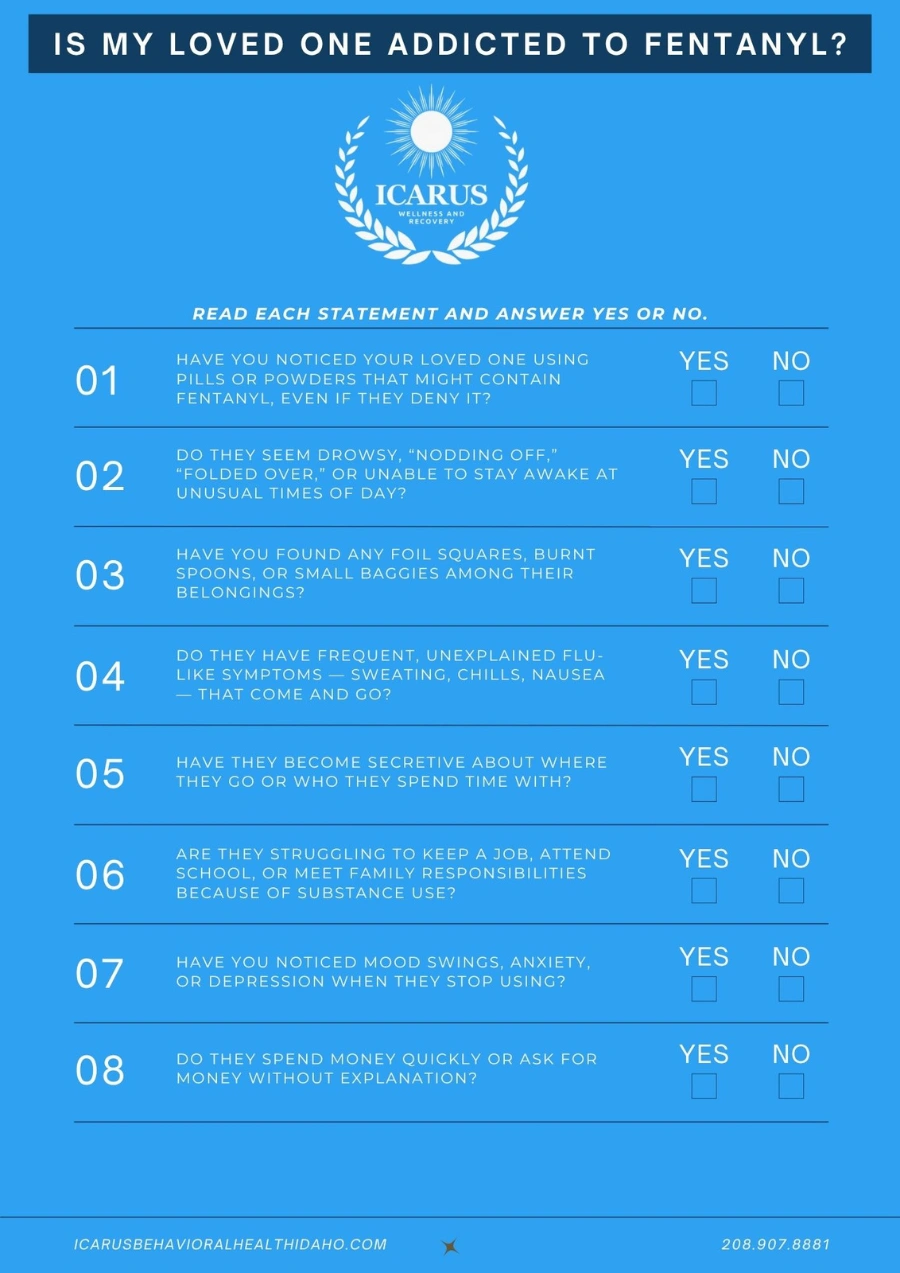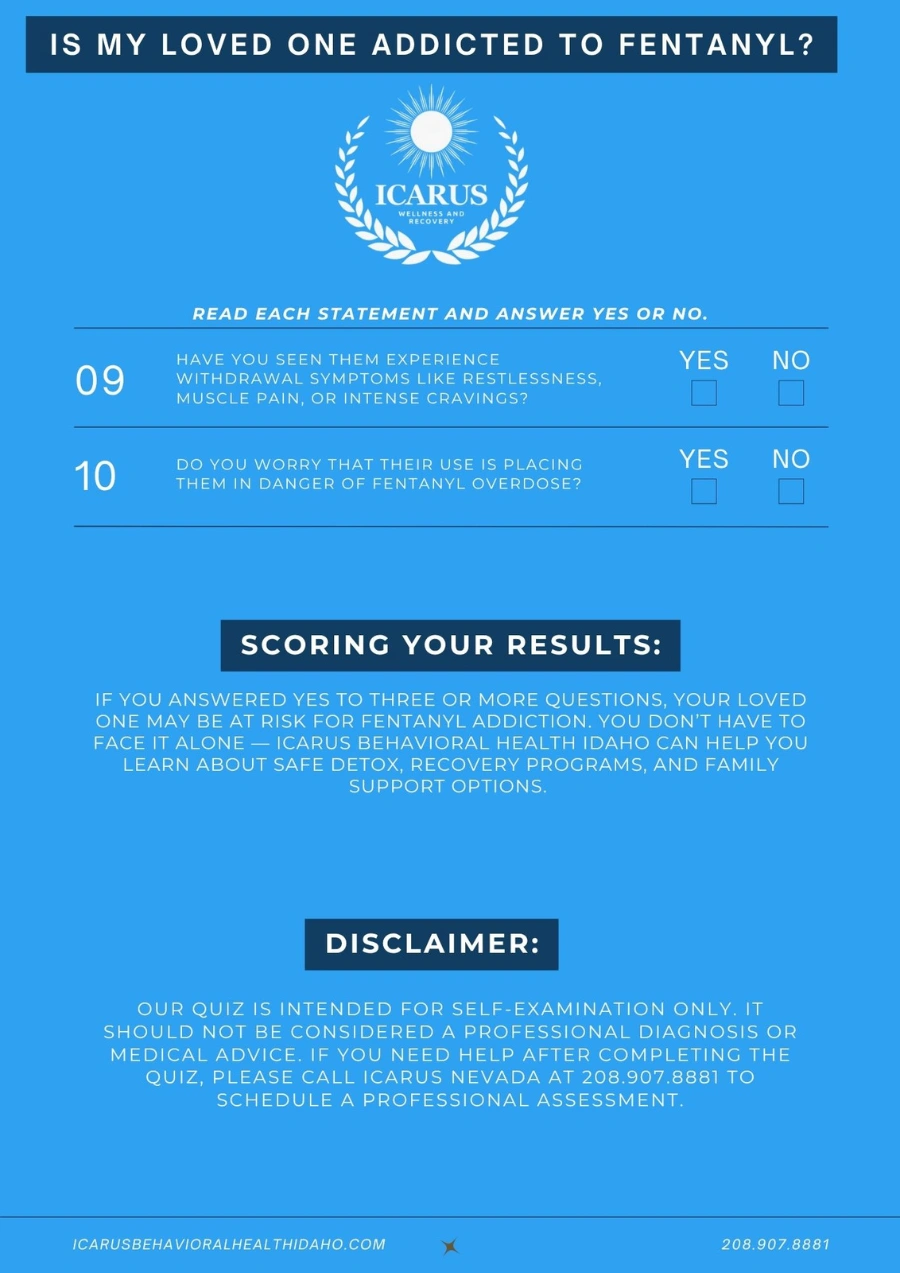Why Do Fentanyl Users Bend Over So Dramatically From The Drug?
When you first see the fentanyl fold, you might find it a disturbing sight. You may see it in a public place or on social media – people slumped over at such a sharp angle that they appear frozen in place.
Once you see it, you might want to learn more, asking: What is the fentanyl fold?
This widespread muscle rigidity isn’t intentional or a result of the person falling asleep. The fentanyl fold is a physical response to fentanyl, a sign that drug abuse has led to central nervous system depression.
Icarus Wellness and Recovery Idaho is a Joint Commission-accredited treatment facility; we’ll give you the most accurate information on the fentanyl fold.
If you have a friend or loved one who is a chronic user of fentanyl or other drugs, this post will help you understand the fentanyl fold, the signs of overdose, and when to call emergency services.
Get Effective Detox and Rehab Options at Icarus
What Is the Fentanyl Fold?
The fentanyl fold, also known as the “fenty fold,” is a sharp forward motion that affects posture and engages the trunk muscles. It happens when someone takes large or multiple doses of the synthetic opioid.
As the person bends forward at the waist (or, less commonly, the neck), their arms become limp and they appear to be in a state of reduced consciousness.
If you are a loved one who has found this page trying to assist someone, it’s essential to know that the person could be in severe danger of respiratory depression or overdose. Act quickly! Administer naloxone (Narcan), a life-saving medication, and call 911 immediately.
The Fentanyl Fold Meaning in Addiction Context
If you described this position to an addiction treatment professional, we would immediately suspect fentanyl use.
This position occurs because of the effects of fentanyl on the person’s central nervous system (CNS), which consists of the brain and spinal cord.
Together, the CNS controls balance, consciousness, and muscle tone. Drug abuse of fentanyl or other opioids suppresses its regular signals. The result is muscle weakness, slow breathing, and loss of coordination to the point of becoming unable to stand upright.
How Fentanyl Enters the Brain and Body
People can take fentanyl in several ways: by injection, smoking, inhaling, pill, or by abusing prescription skin patches. Fentanyl intoxication happens quickly, binding to the brain’s opioid receptors within seconds (inhaling, injecting, smoking) to a few minutes (taking it by pill).
Those brain receptors help regulate pain and pleasure. But, because fentanyl is 50 to 100 times stronger than prescription pain relief medications.
The binding action triggers a dopamine surge and intense euphoria. However, it also means shallow breathing, reduced heart function, and a loss of muscle control.
The Central Nervous System and Fentanyl’s Powerful Depressant Effects
The CNS is the body’s main communication center. When fentanyl, or other substances similar to it, interrupts its messaging, things can get dangerous.
At high doses, or when mixed in counterfeit pill with other substances, it can lead to deep sedation, confusion, or muscle relaxation so overwhelming that the person can’t remain upright, dropping into the fentanyl fold position.
Can the Fentanyl Fold Occur with Other Opioid Use?
Technically, the folded position can happen with other opioid intoxication, including heroin, oxycodone, or morphine. However, medical professionals see it far more often with fentanyl because of its extreme potency and quick binding to the opioid receptors.
Muscle Weakness, Loss of Coordination, and Postural Collapse
Lax muscles and loss of coordination are typical signs of opioid intoxication. As the fentanyl interacts with the brain, it interrupts the release of motor control signals. It leads to floppy, unresponsive muscles and the tendency to nod off that occurs while standing or sitting.
The rigid position can be a warning sign of other life-threatening complications, including respiratory depression and poor circulation; it becomes more of an emergency if they remain in this state for an extended period.
Other Drugs and Polysubstance Use in the Fentanyl Fold
In many cases, the fentanyl fold happens when someone combines fentanyl with other drugs, especially sedatives like alcohol or benzodiazepines. Mixed substance abuse intensifies the opioid effects on the CNS. Even a little bit of fentanyl can lead to an opioid overdose.
Some people only learn that fentanyl is often mixed with other street drugs, from methamphetamines to depressants, only after substance use. Street dealers do add fentanyl to make their products faster-acting and more intense; they don’t care about the increased risk to the user.
Short-Term and Long-Term Health Risks of Fentanyl Misuse
Short-term fentanyl users often mention extreme drowsiness, confusion, and distressed breathing. Extended use leads to damage to the heart, lungs, and brain, and increases the risk of sores or abscesses from sharing needles.
Psychologically, longer use rewires the brain’s natural reward system. Users find it almost impossible to feel good without using fentanyl. Both the physical and mental health concerns must be treated holistically in a licensed medical setting for lasting recovery.
How Can You Recognize the Signs of a Fentanyl Overdose?
Fentanyl overdoses can be quick. Watch for the following signs:
- Extreme drowsiness
- Unresponsiveness
- Slow breathing
- Pinpoint pupils
- Choking or gurgling noises
- Blue lips
- Nodding off – folding at the neck – or a full fentanyl fold
Each of these signals the need for emergency help.
Get Accredited Treatment Programs at Icarus
Immediate Steps to Take if Someone “Folds” or Appears Unresponsive
If you see someone folded over, they could be overdosing. Here are the steps you need to take right away, according to the Centers for Disease Control (CDC):
- Call 911 immediately; get first responders on the scene with the tools for reversing the impact of fentanyl.
- Give naloxone by inserting the spray nozzle into one nostril and depressing the plunger to dispense the medication. Do not test the spray before using it; you’ll waste the dose.
- Try to keep the person away by talking to them or even giving their arm a gentle squeeze.
- Still unresponsive? Check their breath; start rescue breathing until first responders arrive on the scene.
- Stay with the person to explain to EMS workers about the substance use and what steps you’ve already taken.
An ambulance will take the person to the nearest emergency department for physical treatment. There, a clinical case manager or social worker will likely recommend local treatment center options. This time could be their chance for long-term recovery.
Understanding Fentanyl Addiction and Its Hold on the Brain

Fentanyl addiction happens fast because of how potent it is and how fast it changes the brain’s reward center.
Many try it to relieve pain or anxiety, quickly finding themselves in physical dependence. Without it, the person’s mental and physical health suffers harmful symptoms.
Getting Past Fentanyl Withdrawal Symptoms and Starting Recovery
Stopping fentanyl abuse requires medically supervised detox. Quitting at home is not safe. In a 24/7 medical detox setting, professionals can ease withdrawal symptoms by offering safe, proven prescriptions to reduce cravings and ease any physical discomfort.
Some common withdrawal symptoms include:
- Sweating or chills
- Muscle pain
- Stomach upsets
- Anxiety
- Insomnia
- Intense drug cravings
These can be severe to the point that the person uses fentanyl again to make them stop. A relapse, even after just a few days of sobriety, can lead to an overdose. The body begins to heal after the individual becomes clean and sober. As a result, the person’s tolerance starts to drop. This scenario can lead to an awful outcome if they use drugs again.
As they end the near of the detox stage, a clinician transitions the client into therapy, which usually includes one-on-one treatment or support groups. At Icarus Idaho, each client receives a customized, evidence-based treatment plan to address their specific needs.
Harm Reduction Strategies and Safer Practices When Seeking Help
Not everyone is ready to go to treatment. If you’re the loved one of a struggling person, that can be a bitter reality. But harm reduction strategies can help you reduce their risk.
What to try? Encourage the person to:
- Carry Narcan. Always.
- Avoid mixing fentanyl with alcohol or other substances.
- Use test strips to avoid using substances that have been contaminated with fentanyl.
- Don’t use alone; use a buddy system to increase survival chances in the event of an overdose.
- Seek answers to questions they have about their drug use.
The only way to stay 100% safe from fentanyl use is to avoid all illicit drugs. It can lurk in almost any street substance these days.
Even though many who use drugs know this, only that person can choose to seek help. Be calm and non-judgmental while discussing harm reduction or treatment options.
Up To 100% of Rehab Costs Covered By Insurance
Turn to Icarus Wellness for Trusted Fentanyl Addiction Treatment Programs
We encourage placing a call to Icarus Wellness & Recovery today if your loved one has expressed the desire to stop using fentanyl or any other addictive substances.
Our treatment center understands the many effects of fentanyl. We work with each client to discover the underlying causes of addiction and treat the mental and physical aspects of drug addiction.
The Icarus Wellness team also believes that cost shouldn’t be a barrier to anyone seeking fentanyl addiction treatment. We work with top group health insurance carriers to ensure access to our programs. Our admissions team will be happy to help you get your benefits pre-certified and save money on care.
Call us confidentially for more information on our programs to help fentanyl users achieve success in recovery.








